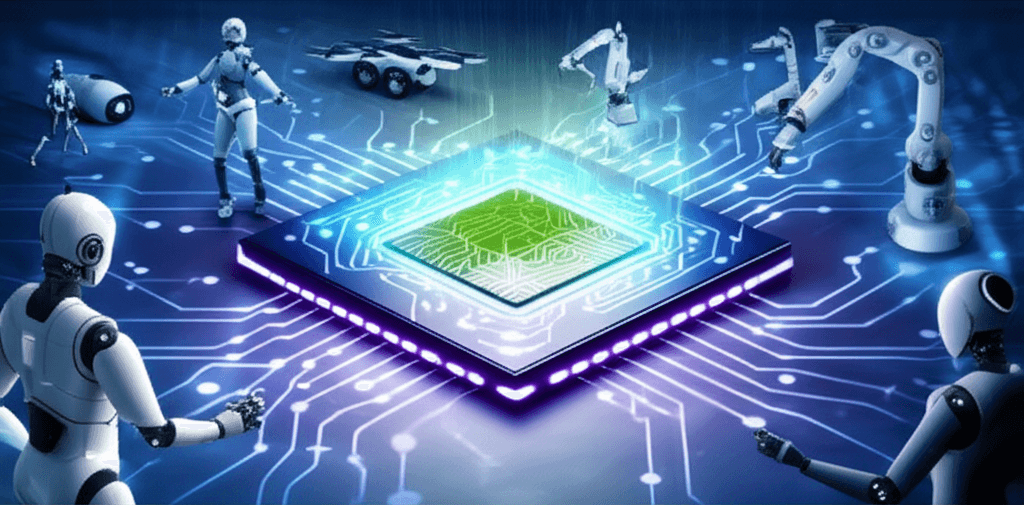NVIDIA's Jetson Thor Powers Physical AI, Bringing Server-Class Intelligence to Edge Robots
NVIDIA's robotics 'brain' unleashes generative AI at the edge, accelerating a new era of physical AI and intelligent machines.
August 26, 2025

NVIDIA has officially released its highly anticipated Jetson AGX Thor, a powerful robotics computer positioned as the "brain" for the next generation of autonomous machines and physical AI. Now generally available, the developer kit is priced at $3,499, packing server-class performance into a compact module designed for edge deployment.[1][2][3] This new system-on-module represents a monumental leap in computational power, enabling robots to perform complex tasks with real-time reasoning, a capability previously confined to the cloud.[4][5] The launch signals a pivotal moment for the robotics industry, promising to accelerate the development of everything from humanoid robots to advanced industrial automation and autonomous vehicles.[6][7]
At the heart of Jetson Thor's massive performance uplift is NVIDIA's latest Blackwell GPU architecture, which for the first time unifies the company's server, PC, and edge computing lines under a single architecture.[8] This powerful GPU, combined with a 14-core Arm Neoverse-V3AE CPU and 128GB of high-speed memory, delivers up to 2,070 FP4 teraflops of AI compute.[9][10] This figure represents a staggering 7.5-fold increase in AI performance compared to its predecessor, the already formidable Jetson Orin.[1][11][2] Furthermore, Jetson Thor achieves this power with 3.5 times greater energy efficiency, a critical factor for battery-powered mobile robots.[1][11][2] This efficiency allows the system to operate within a configurable power envelope of 40 to 130 watts, making it adaptable for a wide range of robotic forms and functions.[10][3] The module also introduces advanced I/O capabilities, including support for high-speed sensor fusion through multiple 25GbE networking ports, essential for processing concurrent data streams from various sensors in real time.[12][13]
The sheer computational horsepower of Jetson Thor is purpose-built to run the large, sophisticated generative AI models that are driving the industry's shift from single-purpose machines to generalist robots.[12][8] This new paradigm of "physical AI" requires robots to perceive, reason, and interact with the unstructured and dynamic human world, a challenge that demands on-device, low-latency processing.[4][14] Jetson Thor is engineered to run a wide variety of generative AI models—from vision language models (VLMs) and large language models (LLMs) to vision language action (VLA) models like NVIDIA's own Isaac GR00T N1.5—directly at the edge.[12][7] This capability minimizes reliance on the cloud, enabling robots to make intelligent decisions and react instantly to their surroundings, a necessity for safe and effective operation in logistics, manufacturing, and healthcare.[5][15] The system's Multi-Instance GPU (MIG) technology further enhances this by allowing a single GPU to be partitioned into isolated instances, ensuring predictable performance for critical, time-sensitive tasks while running other processes in parallel.[12]
The implications of this technology are already being recognized by leaders across the robotics landscape. Over 2 million developers are now part of the NVIDIA Jetson ecosystem, and a growing list of industry giants are among the early adopters of Jetson Thor.[1][11] Companies like Agility Robotics, Boston Dynamics, Figure, and Amazon Robotics are integrating or evaluating the new computer to power their next-generation systems.[1][16] Agility Robotics plans to use Thor in the sixth generation of its Digit humanoid robot to enhance real-time perception and decision-making for logistics tasks.[4] Boston Dynamics is integrating it into its Atlas humanoid robot to leverage server-level compute on the device itself.[17] The platform's reach extends beyond humanoids, with applications in surgical assistants, agricultural machinery, and industrial manipulators, all benefiting from the ability to run more complex AI models at the edge.[7][18][17]
By making the Jetson AGX Thor developer kit available, NVIDIA is providing the essential tools for this robotics revolution.[14] The $3,499 price point makes this advanced technology accessible to a broad range of developers, researchers, and companies.[13][19] The hardware is supported by a comprehensive, full-stack software platform, including NVIDIA Isaac for robotics simulation and development, the Isaac GR00T foundation models for humanoids, NVIDIA Metropolis for vision AI, and NVIDIA Holoscan for real-time sensor processing.[12][20] This robust ecosystem is designed to streamline the development pipeline, from cloud-based training and simulation to real-world deployment on the edge.[6][18] By providing both the powerful "robot brain" and the software to program it, NVIDIA is laying the groundwork for a future where intelligent machines can operate autonomously and collaboratively in human environments.[2]
Sources
[1]
[3]
[4]
[6]
[7]
[8]
[10]
[12]
[13]
[14]
[15]
[16]
[17]
[18]
[19]
[20]